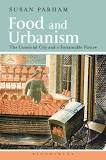Food and Urbanism: The Convivial City and a Sustainable Future

Food and Urbanism, by Susan Parham, explores the interconnections between food and cities using the lens of urbanism. She analyses how transforming spaces of food and cities contributes to convivial and sustainable living, and may affect these attributes in a largely urbanized future. Parham leads the reader on a journey through time and space, from the kitchen table to the urban peripheries and food regions. Here, using case examples from both primary and secondary sources and a wide range of disciplines, she re-establishes connections between food and spatial design as key elements of the interplay between physical form and social, economic and cultural practice (page 269).
Comprising nine chapters, plus an Introduction and Conclusion, Parham partitions the book into three sections: Part 1, “Food, Domesticity and Design”; Part 2, “Gastronomy and the Urbanism of Public Space”; and Part 3, “Food, Space and Urbanism on the Edge”.
Part 1 commences by providing a look at urbanism’s connections to food in the private domain. Starting at the kitchen table, it moves out to finish in the domestic garden. In Chapter 1 Parham examines the role the table, or its symbolic equivalent, plays as a fundamental place “for expressing conviviality through sharing food” (page 19). As such she traces their historical evolution and considers their convivial and exclusionary capacities, with particular attention to design. With a key interest in how private gardens can reflect convivial urban design principles and thus contribute to sustainable urbanism, Chapter 2 illustrates how designed private gardens historically contributed to urban food productivity. It also shows how these gardens have shifted to being predominant places for consuming food, albeit with a recent informal resurgence of food production (page 47).
Part 2 shifts from the private to the public domain as it considers the conventional urbanism of outdoor spaces, namely food streets, shops and markets, as well as gastronomic townscapes and urban green areas (page 1). Chapter 3 argues that perhaps the most important way that food is central to urban life, space and social practices is through the everyday interplay between people and food in public places, namely food markets and shops. Therefore it explores the role of food markets in urbanism and the regeneration of urban food quarters (page 72). The following chapter expands in scale to consider other elements in the gastronomic townscape and their relation to creating convivial food-related land uses and sustainable urbanism (page 97). Both extending and countering the preceding two chapters, Chapter 5 explores how spatial and cultural changes linked to the rise of suburbia have shaped connections with food (page 130). Chapter 6 continues by looking at the green space of cities as convivial or productive spaces, and gives particular focus to design and planning elements and related transformations of the urban food-growing trajectory (page 157).
Part 3 looks at the productive periphery of cities, how the development of conurbations affects food, and food space in city regions and the countryside (page 1). Drawing on cases in Italy and France, Chapter 7 considers how some cities create the gastronomic landscape of their urban peripheries and what elements “support positive peri-urban food design and planning” (page 189). Scaling up, Chapter 8 explores the spatiality of food at the larger metropolitan scale, and uses a food-centred design analysis to study new urban forms stemming from megalopolises (page 215). Chapter 9 then expands beyond urban and peri-urban foodscapes to urbanism of the wider food region.
To conclude, Parham consolidates key themes in her book. She also reiterates that the nature of food’s relationship to spatial design has significant capacity to support or undermine our cities as sustainable and convivial places (page 269).
Book note prepared by Hannah Keren Lee
Search the Book notes database
Our Book notes database contains details and summaries of all the publications included in Book notes since 1993 - with details on how to obtain/download.
Use the search form above, or visit the Book notes landing page for more options and latest content.
For a searchable database for papers in Environment and Urbanization, go to http://eau.sagepub.com/

